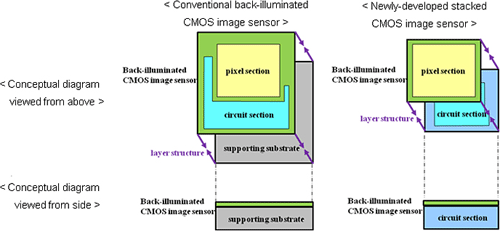Sony: next-gen sensors improve resolution, low-light shooting
posted Monday, January 23, 2012 at 1:03 PM EDT
 Camera phones are ubiquitous these days, but many have yet to match the image quality even of very affordable compact cameras. New sensor technology from Sony Corp. aims to improve the situation.
Camera phones are ubiquitous these days, but many have yet to match the image quality even of very affordable compact cameras. New sensor technology from Sony Corp. aims to improve the situation.
Compared to existing backside illuminated CMOS image sensors, the newly-announced design moves more peripheral circuitry beneath the active pixels, replacing the supporting substrate in the process and reducing the overall sensor size. Sony has announced two chips based on the new design, slated to arrive this year. First to arrive will be a 1/4"-type BSI CMOS sensor with eight megapixel resolution. Sample shipments will begin for this chip in March 2012. This will be followed with a slightly larger 1/3.06"-type BSI CMOS sensor that has a higher resolution of 13 megapixels, which should be available for manufacturer sampling from June 2012.
The latter sensor will include two features absent from the eight megapixel chip, although a variant adding these will be available at eight megapixels from August 2012.

The first is an RGBW pixel layout, which will improve sensitivity at the expense of some color resolution by leaving one in every four pixels unfiltered, allowing it to capture more light. The sensor itself will be able to provide output as if it were a standard RGBG chip, saving manufacturers needing to update their image processing pipeline. Sony says that although the new chips have a pixel pitch of 1.12μm, they will offer sensitivity equivalent to a 1.4μm pixel pitch with a conventional Bayer pattern.
The other interesting feature is an HDR Movie mode, which allows the exposure time to be varied by pixel, providing two different exposures across the image frame. This is then combined in-camera to yield a movie with greater exposure latitude, allowing for example a properly exposed foreground subject while still retaining some cloud detail in the bright sky behind.
Given that the sensors themselves will be sampling towards the middle of 2012, we'd expect to see the first products based on these technologies arrive at retail towards the end of the year.
Press Release
Sony Develops Next-generation Back-Illuminated CMOS Image Sensor which Embodies the Continuous Evolution of the Camera
- Expanding Shooting Enjoyment and Advanced Functionality of Smartphones and Other Devices -
Tokyo, Japan - January 23, 2012 - Sony Corporation (“Sony”) today announced that it has developed a new next-generation back-illuminated CMOS image sensor which embodies the continuous evolution of the camera. This image sensor layers the pixel section containing formations of back-illuminated structure pixels onto chips containing the circuit section for signal processing, which is in place of supporting substrates for conventional back-illuminated CMOS image sensors. This structure achieves further enhancement in image quality, superior functionalities and a more compact size that will lead to enhanced camera evolution.
Hereafter, Sony will position it as the next generation back-illuminated CMOS image sensors, and unwaveringly strive to further develop this image sensor and expand its product lineup, thereby contributing to the further development of user-friendly cameras and to shooting enjoyment.
Features of stacked CMOS image sensor
-
Large-scale signal processing circuits required for higher image quality and better functionality are built-in
-
More compact image sensor chip size
-
Even higher image quality of the pixel section by adopting manufacturing processes specialized for superior image quality
-
Faster speeds and lower power consumption by adopting the leading process for the circuit section
Background of development
The popularization of smartphones and other devices in recent years has been accompanied by an increasingly diverse use of camera functionality. This has brought heightened demand for more sophisticated cameras, to ensure adaptability to a wider range of scenes and Sony developed this stacked CMOS image sensor to meet such demand. In addition to the higher pixel numbers, superior image quality and faster speeds which conventional image sensors pursued, the newly-developed image sensors further achieve more highly-advanced functionalities and a more compact size, thus paving the way for enhanced camera evolution.
As the first step towards the commercialization of its new CMOS image sensors, Sony has developed a model with built-in signal processing functionality, an element that usually requires external embedment. Samples will be shipped from March, 2012. Accordingly, models have been developed with Sony’s unique “RGBW Coding” function, which facilitates low noise, high quality image capture even in low light condition, and the proprietary “HDR (High Dynamic Range) Movie” function, which achieves brilliant color even when taking pictures against bright light.
About stacked CMOS image sensors
Conventional CMOS image sensors mount the pixel section and analog logic circuit on top of the same chip, which require numerous constraints when wishing to mount the large-scale circuits such as measures to counter the circuit scale and chip size, measures to suppress noise caused by the layout of the pixel and circuit sections, and optimizing the characteristics of pixels and circuit transistors.
Sony has succeeded in establishing a structure that layers the pixel section containing formations of back-illuminated structure pixels over the chip affixed with mounted circuits for signal processing, which is in place of supporting substrates used for conventional back-illuminated CMOS image sensors. By this stacked structure, large-scale circuits can now be mounted keeping small chip size. Furthermore, as the pixel section and circuit section are formed as independent chips, a manufacturing process can be adopted, enabling the pixel section to be specialized for higher image quality while the circuit section can be specialized for higher functionality, thus simultaneously achieving higher image quality, superior functionality and a more compact size. In addition, faster signal processing and lower power consumption can also be achieved through the use of leading process for the chip containing the circuits.
Sony Develops New “RGBW Coding” and “HDR Movie” Functions
- To be Equipped in First Release of New Stacked CMOS Image Sensors, To Begin Sample Shipment -
Tokyo, Japan - January 23, 2012 - Sony Corporation (“Sony”) today announced the development of two CMOS image sensor models designed for use in smartphones and other devices. They are equipped with Sony's unique “RGBW Coding” function which allows images to be captured with low noise and high picture quality even in low-light conditions. They also contain Sony's “HDR (High Dynamic Range) Movie” function which allows brilliant color to be captured even in bright settings. Sony has also developed a model with built-in signal processing functionality, an element that usually requires external embedment.
Sony has successfully developed new stacked CMOS image sensor technology that realizes higher image quality and superior functionality in a more compact size. The three newly developed next-generation back-illuminated CMOS image sensor models will be the first to utilize this technology. Samples will begin to successively ship starting March 2012.
Background of development (new functions)
The recent proliferation of smartphones and other devices has increased casual shooting opportunities and there is demand for the evolution of cameras to be able to shoot in a diverse range of settings. In particular, consumers want to easily take pictures in low light conditions or those with both low and bright lights. Sony has incorporated its two newly developed models with its unique “RGBW Coding” function which enables high-sensitivity shooting even in low-light conditions and its “HDR Movie” function which can capture images or video across a broad dynamic range of low-light to bright-light conditions.
About the key functions incorporated in the new CMOS image sensors
-
Sony's unique “RGBW Coding” function enabling clear shooting in dark rooms or at night
The built-in “RGBW Coding” function which adds W (White) pixels to the conventional range of RGB (Red-Green-Blue) pixels has realized higher sensitivity, enabling high-quality shooting with low noise even in dark indoor or night settings.While the addition of W (White) pixels improves sensitivity, it has the problem of degrading image quality. However, Sony's own device technology and signal processing realizes superior sensitivity without hurting image quality. Furthermore, while the individual pixels of the newly developed models are extremely minute at 1.12μm, the incorporation of the “RBGW Coding” function has realized a SN ratio (signal-to-noise ratio) equivalent to that of a unit pixel size of 1.4μm under conventional methods, which in turn has enables the image sensors to achieve a higher resolution at a more compact size.
The new models are also able to output signals through the conventional RGB method, thus there is no need to change the signal processing adopted in existing devices.

Comparison of Sample pictures in low-light setting
(10 lux)
-
“HDR (High Dynamic Range) Movie” function which enables brilliant colors to be captured even in bright settings
The built-in “HDR Movie” function enables brilliant colors to be captured even in settings with a wide range of light including bright light.Typically, when shooting with differing light levels, such as an indoor setting against a bright outdoor background, there can easily be blocked up shadows for dark areas or blown out highlights for bright areas. Such phenomena are a result of the combination of low-light and bright-light which have different optimal exposure conditions in the same shot. This function reduces this by setting two different exposure conditions within a single screen shooting and conducts the appropriate signal processing for the captured image information under each optimal exposure condition. This process generates an image with a broad dynamic range and enables shooting of both the background and subject matter with brilliant colors even in a bright environment.
| Normal Movie (Left) | HDR Movie (Right) |
 |
|
Upcoming product launches (plan)
-
Type 1/4 Stacked CMOS Image Sensor with approx. 8.0 effective megapixels
(equipped with camera signal processing function*1)
Sample shipments planned for March, 2012 -
Type 1/3.06 Stacked CMOS Image Sensor with approx. 13.0 effective megapixels
(equipped with “RGBW Coding” and “HDR Movie” functions)
Sample shipments planned for June, 2012 -
Type 1/4 Stacked CMOS Image Sensor with approx. 8.0 effective megapixels
(equipped with “RGBW Coding” and “HDR Movie” functions)
Sample shipments planned for August, 2012
*1 Not equipped with “RGBW Coding” or “HDR Movie” functions